In the ever-evolving landscape of digital marketing, programmatic advertising has emerged as a game-changer, particularly for industries with unique regulatory and competitive challenges, such as online gambling. As technology continues to reshape how businesses reach potential customers, understanding the nuances of programmatic advertising becomes essential for brands in the gambling sector.
This comprehensive guide delves into the intricate world of programmatic advertising, providing insights tailored specifically for online gambling operators, affiliates, and marketers.
If you have been using online advertising for yourself or your business, then you must have come across the word “programmatic advertising”.
In the advertising industry, many have used this term as a reference to how it drastically changed the world of online advertising. And there is a good reason for that. In 2018, 80% of digital marketing in the United States was conducted via programmatic advertising.
In this guide, we will walk you through the different notions and jargon of programmatic advertising to have a firm grasp of the subject.
Why Use Programmatic Advertising for the iGaming Industry?
As traditional advertising methods become less effective in capturing the attention of a tech-savvy audience, programmatic advertising offers a data-driven approach that automates the buying and selling of ad space in real time.
This efficiency enables gambling companies to target their advertising efforts with precision, ensuring the right message reaches the right audience at the right time. From understanding key concepts to exploring best practices and compliance considerations, this guide aims to iGaming marketers with the knowledge needed to navigate the complexities of programmatic advertising successfully.
Join us as we explore the benefits, strategies, and challenges associated with programmatic advertising in the online gambling industry, empowering you to leverage this powerful tool to drive customer acquisition, boost brand visibility, and enhance overall marketing performance.
What is programmatic advertising?
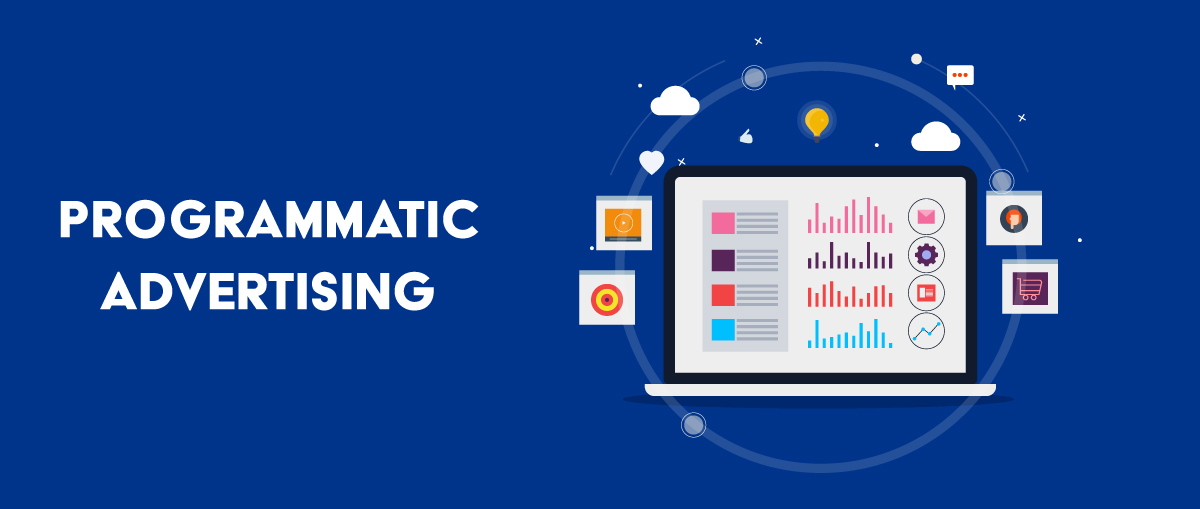
Roughly, programmatic advertising is the use of advanced algorithms of machine learning to buy advertising in real time. This process takes the human aspect out of the buying process. So, instead of having to go through human negotiation, lists of pre-set prices, and manually adjusting the bids and campaign settings, all this process will be done by machines communicating together.
Who is part of this communication?
How does it happen?
And can humans intervene in this?
The answers to these questions will be in the upcoming parts of this article.
What are the uses of programmatic advertising? And who uses it?
Programmatic advertising is the future of the buying and selling of advertising space online. The industry of digital advertising is run by ad exchanges that are responsible for bringing together publishers and advertisers. In the case of programmatic advertising, such exercise is done through running computer code which will automate these auctions and transactions.
Programmatic advertising allows ad exchanges to manage their core business operation with ease and flexibility, enabling them to sell their inventory in an organized manner. Programmatic is beneficial for a variety of companies thanks to its omnipresence in multiple channels such as display, video, mobile, and social.
And as expensive technologies like artificial intelligence and machine learning become more available, smaller companies, using programmatic, get the chance to compete with larger brands without going bankrupt. The first actual recorded instance of programmatic advertising was real-time bidding also known as RTB. RTB was designed to tackle the targeting issue ad networks were facing.
What is Real-Time Bidding (RTB)?
Simply put, real-time bidding is the act of buying and selling through, as you might have guessed, real-time auctions. These transactions will happen in the time it takes for a webpage to load, which is 100 ms.
a) A brief history of real-time bidding
Real-time bidding, as mentioned above, helps solve the targeting feature ad networks were facing. Ad networks are companies that merge unsold inventory from different publishers and make it accessible for discounted prices. Premium inventory, however, was still handled by humans manually and curated based on cases. Any unsold inventory, premium or not, was sold to the highest bidder. This approach solved many problems but not that of targeting. And this is where RTB comes in.
b) How does RTB work?
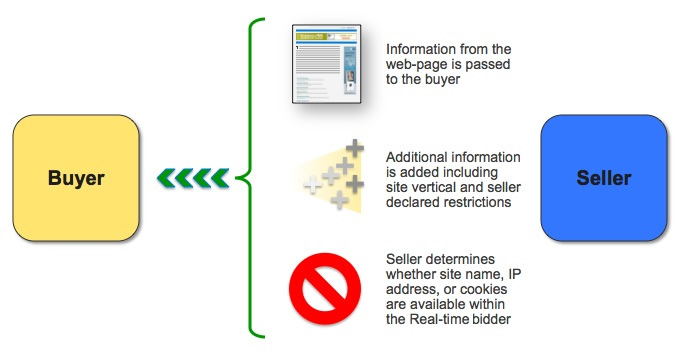
Figure 1: How RTB works
As a concept, RTB is quite easy to understand. You can even develop your bidder applications if you are comfortable with programming. Here’s how it works: when a user enters a website, information about the website along with the user data is sent to an ad exchange in the form of a request.
That information, in the next step, is matched against a list of available advertisers that match the given criteria, and real-time bidding or auction takes place between the eligible advertisers. That’s it!
For instance, let’s say you visit a particular E-commerce website that sells sunglasses, but you end up leaving before making a purchase. Later, while browsing the web, you visit a news site, and you begin to see sunglasses ads everywhere. Real-time bidding is what makes this possible.
Companies, thanks to RTB, have the possibility of targeting users that visited their website but did not make a purchase; such as you, in our example. Brands can show x ads on y website to an audience that matches the criteria brands set. In our case, in the time it takes you to load the webpage, a real-time auction takes place between sunglasses brands and the winner will get to show you their ad on the publisher’s website hoping you convert.
The focused, per-case approach RTB offers better, swifter, and more precise targeting so only visitors from your target audience will see your ads. The exciting thing about RTB is that your brand will have the opportunity to outbid multinational brands for visitors that matter most to you.
c) How is RTB different from programmatic advertising?
RTB, as aforementioned, was the beginning of programmatic technology. This is to say that RTB is an aspect, part, or a form of programmatic advertising, but not all programmatic advertising uses RTB.

Figure 2: RTB VS Programmatic advertising
Programmatic advertising is all about automating the ad-buying process, and RTB is one way to do that. While not all programmatic use RTB, most of it does. To quantify this, we can say that 90% of programmatic utilizes RTB. But, let’s give the idea better clarity.
Real-time bidding is a part of the programmatic advertising ecosystem, a part of a whole, and for programmatic advertising to function correctly, other components need to be present. RTB constitutes an approach that helps auction ad space based on a plan that emphasizes individual cases rather than showing everyone the same ad. Essentially, this is the difference between RTB and programmatic advertising. You can think of RTB as an auctioning protocol if this helps you.
d) What are the other forms of programmatic advertising?
Programmatic advertising has additional formats that do not require RTB, and those formats are Programmatic Direct and Private Exchange Buying.
Briefly, programmatic direct refers to buying a fixed amount of impressions on specific sites with an agreed-upon price. Private Exchange Buying refers to a marketplace where one or more selected advertisers get invited by publishers to bid on their inventory. In this scenario, advertisers’ buying platforms are plugged into the publishers’ platforms which allows them to bypass ad-exchange platforms entirely.
In all these formats or forms programmatic advertising can take, specific components need to be there. The buyer or advertiser needs to have a Demand-Side Platform (DSP) connected to a Data Management Platform (DMP). Suppliers need to have a Supply-Side Platform (SSP) for the distribution of their inventory.
In the upcoming parts, we will explain all these terms for you so that you can keep track of everything we have been mentioning so far.
What is a Demand-Side Platform (DSP)?
DSPs are simply software that allows advertisers to buy ad placements in an automated manner. Think of it as a computer code that lets you do your thing with little to no intervention from your side.
a) How does a DSP function?
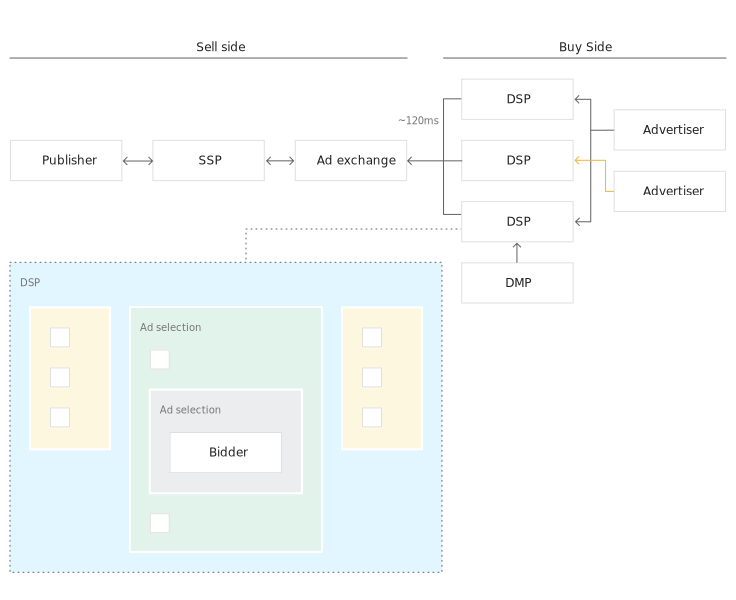
Figure 3: High-level overview of a DSP
To get one thing clear from the start, it is in the ad exchange that the actual buying and selling happens. DSPs need to be connected to ad exchanges to work. To better illustrate this, let us take a real-life example.
When a user comes to a website connected to an ad exchange, an auction signal is sent. The exchange will forward a message to the DSP to ask if any advertisers have any ads that might fit the placement up for auction. If so, the DSP sends a signal back to the exchange to enter a real-time bidding auction with any other advertisers wanting their ads to show. As explained before, the winner of the bid will have their ad shown to the user. This signal exchange accompanied by the RTB constitutes the basis of programmatic advertising for the advertiser’s side.
What is an SPP?
An SSP is very much the same as a DSP. But, instead of being on the advertisers’ side, this one is on the publishers’ side. So, SSP is a computer code that allows publishers to distribute and manage their ad inventory automatically. An SSP connects to an ad exchange platform and tells it what kind of ad inventory is available for sale. And, through real-time bidding, this inventory is sold.
You can expect simple economics to apply to this process. The laws of demand and supply will regulate everything. As you would expect, SSP’s job is to sell the inventory at the highest price possible while a DSP’s job is to buy the inventory at the lowest price permittable. The algorithms behind the software will learn and adjust the pricing the same way demand and supply regulate pricing in a competitive market.
An SSP or DSP can connect to one or multiple ad exchange platforms to maximize exposure. An SSP allows publishers to have more precise control over their inventory as they can set minimum prices and dictate which specific buyers or channels can plug in their platforms to theirs.
What is a Data Management Platform (DMP)?
As with most data systems, a DMP will be used to collect, store, and sort information. DMPs are not used alone, rather are connected to SSPs or DSPs. DMPs’ primary use is the segmentation of incoming cookie data. When properly implemented a DMP allows the right ads to be shown to specific users.
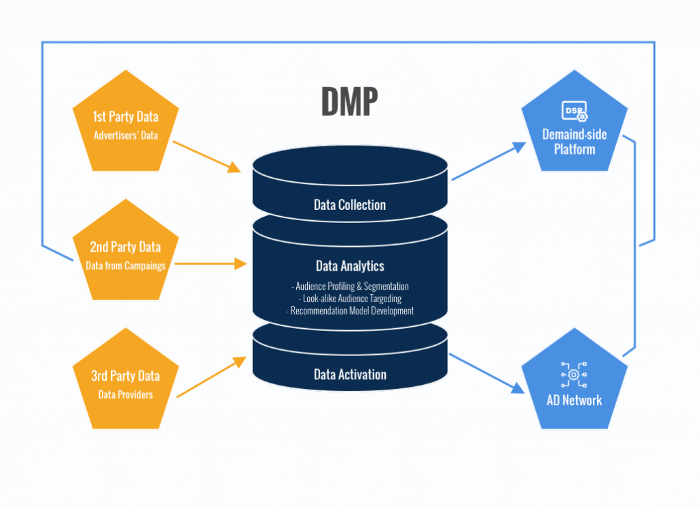
Figure 4: How a DPM works
What is the cost of programmatic advertising?
Programmatic advertising is usually traded on Cost Per Thousand ad impressions (CPM). CPMs, however, can wildly range based on several factors, including the quality of the inventory and the list of targeting. The better quality you want, the more precise you want your targeting, the higher the CPM. Prices in the CPM also vary based on industry, device, format, and page placement. In general, the price of programmatic advertising is low, which will be a huge benefit to small businesses with limited budgets. But, launching huge campaigns might require a stretch of your budget.
What are the advantages of programmatic advertising?
a) Budget-Friendly
One of the best benefits of programmatic advertising is the granular targeting it offers. Programmatic allows you to tip into GDPR compliant data, so you can target the right audience with the right message at the right time. What does this mean to you? This means that you will be using your ad budgets in a better and smarter way; a way that only programmatic offers. This is particularly interesting because you will not be wasting ad impressions on a target that is entirely not interested.
b) Measurement and Optimization
Since programmatic uses real-time bidding and has DMPs plugged in, there is no more need for spreadsheets to be sent here and there to optimize your ads. Programmatic advertising has algorithms that work on the optimization of your ads and performance using real-time data.
c) Transparency
Programmatic advertising allows you to buy ad impressions without having to deal with any third parties or agencies. This technology allows you to buy your ad impressions with full transparency over your fees, and this will enable you to know how your money is being spent and on what.
d) Optimized reporting
Since programmatic advertising uses so much data and is built around business processes that collect the right data, reporting with programmatic is ideal. Your reports will be very data-centric, as well as rich. This will allow you to uncover actionable insights on your ads’ performance and understand your buying patterns. All of this constitutes the perfect recipe for better, smarter marketing decisions.
e) Multichannel
With the increasing number of digital touchpoints of your average user, your advertising should be keeping up. This is where programmatic advertising is leading the charge. It allows you to reach audiences across devices: on mobile, desktop, tablet, in-app, via TV, and even out-of-home. The possibilities are endless!
With user journeys becoming increasingly complex the number of digital touchpoints to reach a user is soaring. Programmatic advertising allows your marketing efforts to keep up as you can reach your users on different platforms including mobile, tablet, desktop, in-app, and even TV. There is no limit to what programmatic can offer you.
The Future of Programmatic Advertising in Online Gambling
Programmatic advertising is poised to play a significant role in the future of online gambling. Its ability to deliver highly targeted ads to specific audiences, optimize campaigns in real-time, and measure performance accurately makes it a compelling choice for gambling operators.
Key Trends and Predictions:
Increased Adoption of AI and Machine Learning: AI-powered tools will continue to refine targeting capabilities, enabling more precise and personalized ad delivery. Machine learning algorithms will optimize bidding strategies, ensuring maximum ROI.
Enhanced Data-Driven Targeting: The use of first-party data, combined with advanced analytics, will allow operators to create highly targeted campaigns that resonate with specific player demographics.
Mobile-First Approach: As more gamblers access online casinos and sportsbooks via their smartphones, programmatic advertising will need to adapt to mobile-specific formats and user behaviors.
Compliance and Regulation: Stricter regulations and increased scrutiny will likely drive the industry towards more transparent and responsible advertising practices. Programmatic advertising can help ensure compliance by automating processes and tracking ad placements.
Innovation in Ad Formats: New ad formats, such as interactive ads and video ads, will provide more engaging experiences for players and offer unique opportunities for advertisers.
Challenges and Opportunities:
- Ad Fraud and Viewability: Addressing ad fraud and ensuring that ads are seen by real users will remain a challenge. Industry-wide efforts to combat these issues will be crucial.
- Privacy Concerns: The increasing focus on data privacy will necessitate careful consideration of how user data is collected and used. Advertisers will need to comply with regulations like GDPR and CCPA.
- Competition: The online gambling market is highly competitive, and operators will need to leverage programmatic advertising to differentiate themselves and acquire new players.
Overall, the future of programmatic advertising in online gambling looks promising. As technology continues to evolve and regulations become more stringent, operators that embrace programmatic advertising and leverage its capabilities will be well-positioned to succeed in this dynamic industry.




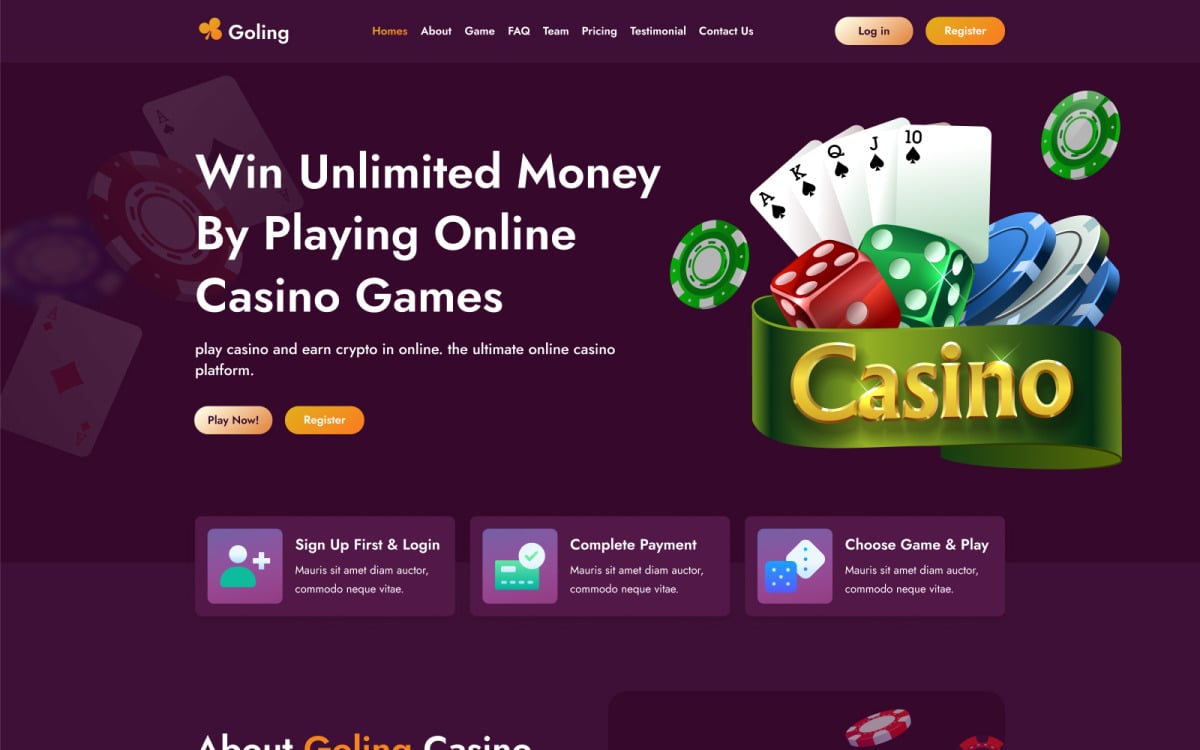
Pingback: Top 10 Recommended Traffic Sources for iGaming Advertising